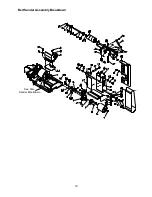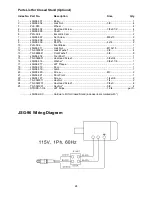
10
Adjustments
Sanding Belt Table Adjustment
Always disconnect the sander
from the power source before servicing or
making any adjustments. Failure to comply
may cause serious injury.
1. Place a square on the sanding belt table with
one edge along the graphite pad, or sanding
belt (Figure 4).
2. If the table is not square to the belt adjust the
table by loosening the two locking handles.
Adjust to the square position and tighten
handles.
3. Place a combination square (A, Fig. 5) in the
miter gauge slot (B, Fig. 5) and check the
distance from the slot to the edge of the
sanding belt. Slide the square along the slot to
the other end of the belt and check the
distance. The distances should be equal to
ensure that the miter gauge travels parallel to
the belt. Loosen the two socket head cap
screws at the bottom of the table, which hold
the table and left trunnion in place to adjust the
distance.
4. Always maintain a gap of approximately 1/16”
between the table edge and belt. Once the
table is square and parallel to the belt adjust
the 90° stop. Loosen the hex nut and tighten
the set screw until it contacts the guide pin,
(Figure 6). Tighten the hex nut. Repeat for the
other side.
5. If you need to sand at a precise angle, loosen
the handles that secure the table in place. Set
a combination square on the table and adjust
to the desired angle. Always maintain a gap of
approximately 1/16” between the table edge
and belt.
Note:
The belt table can be removed and the
disc table can be used in its place. There are
two holes in the base, below the sanding belt,
that will accommodate the disc table’s support
rod and locking handle.
Figure 4
Figure 5
Figure 6










































